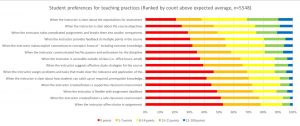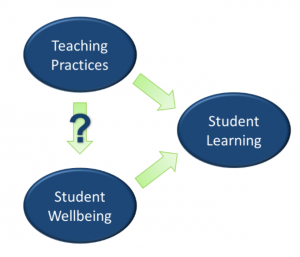
(Photo credit: UBC Public Affairs)
Over the 2015/16 academic year, seven focus groups were conducted with 29 students from the faculties of Arts and Science. Each focus group discussed how different teaching practices impacted their mental health and wellbeing. Our analysis identified five concepts instructors could incorporate into their curriculum in order to support student mental health and wellbeing:
1. The instructor fosters a sense of belonging
Student wellbeing is enhanced when students feel have strong peer relationships and feel a human connection with their instructor. In addition to promoting social wellbeing, a sense of connection helps students weather tough times and reach out when they need help academically. For example, using student names and providing opportunities for students to interact within the class.
2. The instructor supports the whole student
Students have indicated that their wellbeing is supported when instructors are cognizant that students have a life outside of academics. Supporting the whole student means exactly this – recognizing that students have a life outside of academics, and planning the course with this in mind. For example, setting office hours to accommodate for students’ schedules, and incorporating flexibility into the grading scheme (i.e. dropping the lowest test mark or offering extensions).
3. The course content is meaningful and relevant to the student
Student motivation and student wellbeing seem to go hand in hand. Students are more motivated to learn when they find the material valuable to them; this could be accomplished by connecting course material to current events, providing opportunities to engage in community-based learning, or by showing students how course material might relate to a future career.
4. The learning process is engaging
Student wellbeing and motivation is enhanced when the learning process is engaging. Most students prefer an interactive learning environment, where there is a balance between lecture components and more active components such as discussion, questions, demonstrations, video, activities, etc. It also helps when the instructor is passionate about the subject and uses a bit of humour!
5. The instructor effectively supports student learning
Most students attend university to learn – and when they are learning well their wellbeing is also supported. In addition to clearly explaining course concepts, students suggested… Having tutorials and review sessions, as well as being consistent in content difficulty, format, and marking are some of the ways that students have suggested as supportive of their learning.
There you have it – teaching practices that are effective at promoting student mental wellbeing from students’ point of view. We’ll be sharing more info about each topic over the coming weeks. As an instructor, have you engaged in any of the above practices? Have you encountered any barriers when implementing them? Feel free to comment below and share your experiences!





